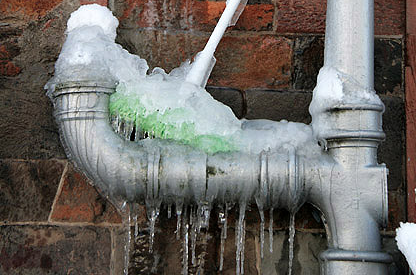Right here down the page you might get a bunch of incredibly good help and advice concerning Winter Plumbing Precautions: Preventing Frozen Pipes.

Winter can damage your pipes, particularly by freezing pipes. Here's how to prevent it from happening and what to do if it does.
Introduction
As temperatures decline, the threat of icy pipes boosts, potentially leading to costly fixings and water damages. Comprehending how to stop icy pipes is crucial for home owners in chilly climates.
Recognizing Frozen Pipelines
What triggers pipelines to freeze?
Pipelines freeze when revealed to temperatures listed below 32 ° F (0 ° C) for extended durations. As water inside the pipelines freezes, it increases, putting pressure on the pipe wall surfaces and potentially triggering them to break.
Risks and damages
Icy pipelines can lead to water system disturbances, home damages, and pricey repairs. Burst pipes can flood homes and trigger substantial architectural damages.
Indicators of Frozen Pipes
Identifying frozen pipelines early can stop them from rupturing.
Exactly how to determine frozen pipes
Search for reduced water circulation from faucets, unusual odors or noises from pipelines, and noticeable frost on revealed pipelines.
Avoidance Tips
Insulating vulnerable pipelines
Wrap pipes in insulation sleeves or make use of warmth tape to safeguard them from freezing temperatures. Concentrate on pipes in unheated or exterior locations of the home.
Heating strategies
Keep indoor spaces sufficiently heated, particularly areas with plumbing. Open up cabinet doors to permit warm air to distribute around pipelines under sinks.
Safeguarding Exterior Plumbing
Garden pipes and exterior faucets
Detach and drain pipes yard hoses before wintertime. Mount frost-proof spigots or cover outdoor faucets with protected caps.
What to Do If Your Pipelines Freeze
Immediate activities to take
If you believe icy pipelines, keep taps open to alleviate pressure as the ice melts. Utilize a hairdryer or towels soaked in hot water to thaw pipes slowly.
Long-Term Solutions
Structural changes
Think about rerouting pipes far from exterior wall surfaces or unheated areas. Add additional insulation to attics, basements, and crawl spaces.
Upgrading insulation
Purchase high-quality insulation for pipes, attics, and walls. Proper insulation aids keep regular temperature levels and decreases the danger of frozen pipes.
Verdict
Stopping frozen pipelines requires positive measures and fast responses. By comprehending the reasons, indications, and safety nets, homeowners can secure their pipes during cold weather.
6 Proven Ways to Prevent Frozen Pipes and Protect Your Home
Disconnect and Drain Garden Hoses
Before winter arrives, start by disconnecting your garden hoses and draining any remaining water. Close the shut-off valves that supply outdoor hose bibs and leave the outdoor faucet open to allow any residual water to drain. For extra protection, consider using faucet covers throughout the colder months. It’s also important to drain water from any sprinkler supply lines following the manufacturer’s directions.
Insulate Exposed Pipes
Insulating your pipes is an effective way to prevent freezing. Pipe insulation is readily available at home improvement stores and is relatively inexpensive. Pay close attention to pipes in unheated areas such as the attic, basement, crawl spaces, or garage. Apply foam insulation generously to create a buffer against the cold. You can also wrap your pipes in heat tape or thermostat-controlled heat cables for added warmth.
Seal Air Leaks
Inspect your home for any cracks or openings that could let in cold air. Seal any holes around the piping in interior or exterior walls, as well as the sill plates where your home rests on its foundation. Additionally, make sure to keep your garage door closed unless you’re entering or exiting. Leaving it open creates a significant air leak that can lead to frozen pipes.
Allow Warm Air Circulation
During cold snaps, it’s essential to allow warm air to circulate evenly throughout your home. Leave interior doors ajar to promote better airflow. Open kitchen and bathroom cabinets to help distribute heat consistently around the rooms. If you have small children or pets, be sure to remove any household chemicals or potentially harmful cleaners from open cabinets for safety.
Let Faucets Drip
A small trickle of water can make a big difference in preventing ice formation inside your pipes. When temperatures drop significantly, start a drip of water from all faucets served by exposed pipes. This continuous flow helps prevent the water from freezing. Additionally, running a few faucets slightly can relieve pressure inside the pipes, reducing the chances of a rupture if the water inside does freeze.
https://choateshvac.com/6-proven-ways-to-prevent-frozen-pipes-and-protect-your-home/

I'm certainly very fascinated with Winter Plumbing Precautions: Preventing Frozen Pipes and I hope you enjoyed reading the entire piece. Do you know about anybody else who is fascinated by Winter Plumbing Precautions: Preventing Frozen Pipes? Why not share it. We treasure reading our article about Preventing and dealing with frozen pipes.
Book-Now
Comments on “Essential Tips to Avoid Frozen Pipes in Cold Weather”